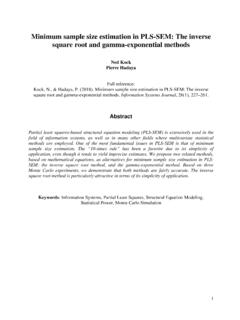Transcription of Deep High-Resolution Representation Learning for Human ...
1 Deep High-Resolution Representation Learning for Human Pose estimation Ke Sun1,2 Bin Xiao2 Dong Liu1 Jingdong Wang2. 1. University of Science and Technology of China 2 Microsoft Research Asia [ ] 25 Feb 2019. Abstract depth In this paper, we are interested in the Human pose es- 1 . timation problem with a focus on Learning reliable high - scale resolution representations. Most existing methods recover 2 . High-Resolution representations from low- resolution repre- sentations produced by a high -to-low resolution network. 4 . Instead, our proposed network maintains High-Resolution feature conv.
2 Down up representations through the whole process. maps unit samp. samp. We start from a High-Resolution subnetwork as the first stage, gradually add high -to-low resolution subnetworks Figure 1. Illustrating the architecture of the proposed HRNet. It one by one to form more stages, and connect the mutli- consists of parallel high -to-low resolution subnetworks with re- resolution subnetworks in parallel. We conduct repeated peated information exchange across multi- resolution subnetworks multi-scale fusions such that each of the high -to-low reso- (multi-scale fusion). The horizontal and vertical directions cor- lution representations receives information from other par- respond to the depth of the network and the scale of the feature allel representations over and over, leading to rich high - maps, respectively.
3 resolution representations. As a result, the predicted key- The recent developments show that deep convolutional point heatmap is potentially more accurate and spatially neural networks have achieved the state-of-the-art perfor- more precise. We empirically demonstrate the effectiveness mance. Most existing methods pass the input through a of our network through the superior pose estimation results network, typically consisting of high -to-low resolution sub- over two benchmark datasets: the COCO keypoint detection networks that are connected in series, and then raise the dataset and the MPII Human Pose dataset.
4 In addition, we resolution . For instance, Hourglass [40] recovers the high show the superiority of our network in pose tracking on the resolution through a symmetric low-to- high process. Sim- PoseTrack dataset. The code and models have been publicly pleBaseline [72] adopts a few transposed convolution layers available at for generating High-Resolution representations. In addition, dilated convolutions are also used to blow up the later lay- ers of a high -to-low resolution network ( , VGGNet or ResNet) [27, 77]. 1. Introduction We present a novel architecture, namely high - 2D Human pose estimation has been a fundamental yet resolution Net (HRNet), which is able to maintain high - challenging problem in computer vision.
5 The goal is to lo- resolution representations through the whole process. We calize Human anatomical keypoints ( , elbow, wrist, etc.) start from a High-Resolution subnetwork as the first stage, or parts. It has many applications, including Human action gradually add high -to-low resolution subnetworks one by recognition, Human -computer interaction, animation, etc. one to form more stages, and connect the multi- resolution This paper is interested in single-person pose estimation , subnetworks in parallel. We conduct repeated multi-scale which is the basis of other related problems, such as multi- fusions by exchanging the information across the paral- person pose estimation [6, 27, 33, 39, 47, 57, 41, 46, 17, 71], lel multi- resolution subnetworks over and over through the video pose estimation and tracking [49, 72], etc.
6 Whole process. We estimate the keypoints over the high - Equal resolution representations output by our network. The re- contribution. This work is done when Ke Sun was an intern at Microsoft Research, sulting network is illustrated in Figure 1. Beijing, China Our network has two benefits in comparison to exist- 1. (a) (b). (d). feature reg. dilated strided up trans. sum (c) maps conv. conv. conv. samp. conv. Figure 2. Illustration of representative pose estimation networks that rely on the high -to-low and low-to- high framework. (a) Hourglass [40]. (b) Cascaded pyramid networks [11].
7 (c) SimpleBaseline [72]: transposed convolutions for low-to- high processing. (d) Combination with dilated convolutions [27]. Bottom-right legend: reg. = regular convolution, dilated = dilated convolution, trans. = transposed convolution, strided = strided convolution, concat. = concatenation. In (a), the high -to-low and low-to- high processes are symmetric. In (b), (c) and (d), the high -to-low process, a part of a classification network (ResNet or VGGNet), is heavy, and the low-to- high process is light. In (a). and (b), the skip-connections (dashed lines) between the same- resolution layers of the high -to-low and low-to- high processes mainly aim to fuse low-level and high -level features.
8 In (b), the right part, refinenet, combines the low-level and high -level features that are processed through convolutions. ing widely-used networks [40, 27, 77, 72] for pose estima- network provides dominant solutions [20, 35, 62, 42, 43, tion. (i) Our approach connects high -to-low resolution sub- 48, 58, 16]. There are two mainstream methods : regressing networks in parallel rather than in series as done in most the position of keypoints [66, 7], and estimating keypoint existing solutions. Thus, our approach is able to main- heatmaps [13, 14, 78] followed by choosing the locations tain the high resolution instead of recovering the resolu- with the highest heat values as the keypoints.
9 Tion through a low-to- high process, and accordingly the pre- Most convolutional neural networks for keypoint dicted heatmap is potentially spatially more precise. (ii) heatmap estimation consist of a stem subnetwork similar to Most existing fusion schemes aggregate low-level and high - the classification network, which decreases the resolution , level representations. Instead, we perform repeated multi- a main body producing the representations with the same scale fusions to boost the High-Resolution representations resolution as its input, followed by a regressor estimating with the help of the low- resolution representations of the the heatmaps where the keypoint positions are estimated same depth and similar level, and vice versa, resulting in and then transformed in the full resolution .
10 The main body that High-Resolution representations are also rich for pose mainly adopts the high -to-low and low-to- high framework, estimation . Consequently, our predicted heatmap is poten- possibly augmented with multi-scale fusion and intermedi- tially more accurate. ate (deep) supervision. We empirically demonstrate the superior keypoint detec- high -to-low and low-to- high . The high -to-low process tion performance over two benchmark datasets: the COCO. aims to generate low- resolution and high -level representa- keypoint detection dataset [36] and the MPII Human Pose tions, and the low-to- high process aims to produce high - dataset [2].
![arXiv:0706.3639v1 [cs.AI] 25 Jun 2007](/cache/preview/4/1/3/9/3/1/4/b/thumb-4139314b93ef86b7b4c2d05ebcc88e46.jpg)

![arXiv:1301.3781v3 [cs.CL] 7 Sep 2013](/cache/preview/4/d/5/0/4/3/4/0/thumb-4d504340120163c0bdf3f4678d8d217f.jpg)
![@google.com arXiv:1609.03499v2 [cs.SD] 19 Sep 2016](/cache/preview/c/3/4/9/4/6/9/b/thumb-c349469b499107d21e221f2ac908f8b2.jpg)







